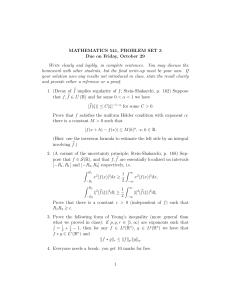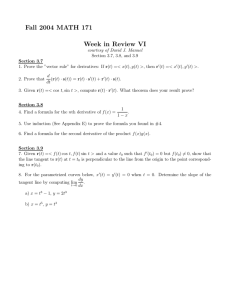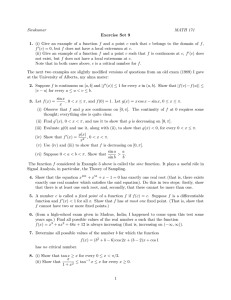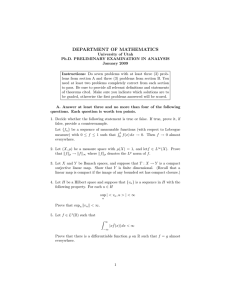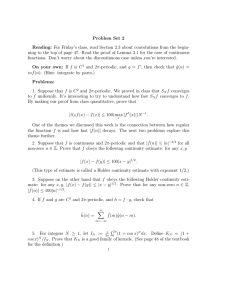Math5700, Capstone Course, Spring 2013 All Quizzes for the semester ∣4x−5∣+2≥8 3
advertisement
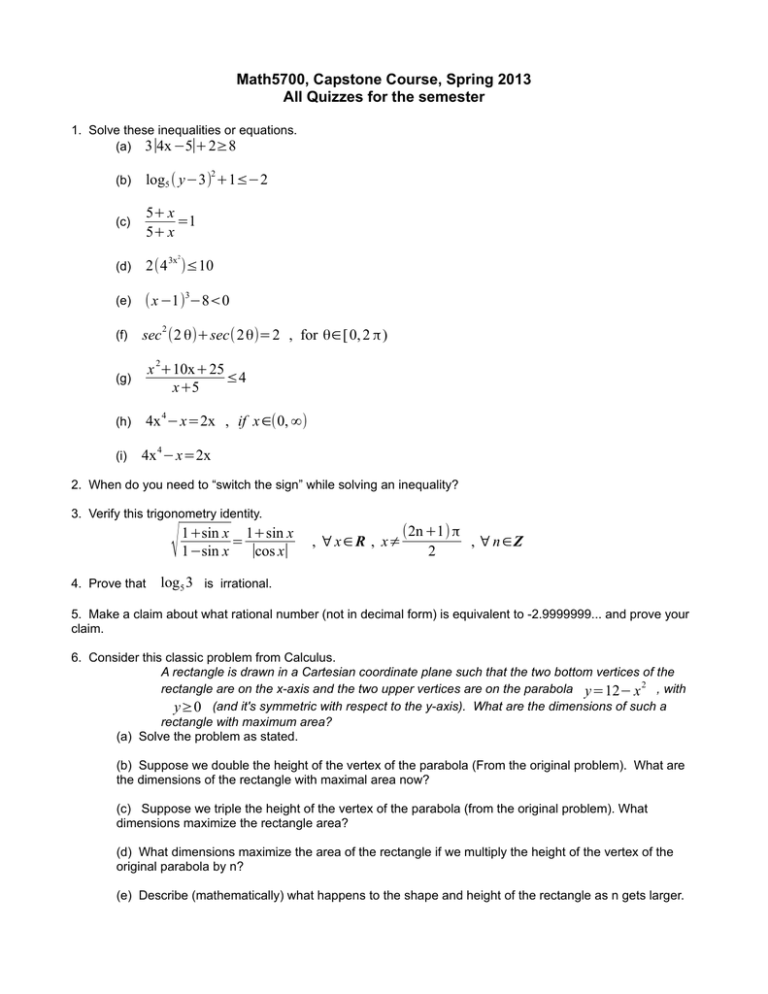
Math5700, Capstone Course, Spring 2013
All Quizzes for the semester
1. Solve these inequalities or equations.
(a) 3∣4x −5∣+2≥8
2
(b)
log5 ( y−3) +1≤−2
(c)
5+ x
=1
5+ x
(d)
2(4 3x )≤10
(e)
( x −1)3−8<0
(f)
sec 2 (2 θ)+sec( 2 θ)=2 , for θ∈[ 0, 2 π )
2
(g)
x 2+10x+25
≤4
x+5
(h)
4x 4 −x=2x , if x ∈(0, ∞)
(i)
4
4x −x=2x
2. When do you need to “switch the sign” while solving an inequality?
3. Verify this trigonometry identity.
√
4. Prove that
1+sin x 1+sin x
=
1−sin x ∣cos x∣
, ∀ x ∈ R , x≠
(2n +1) π
, ∀ n ∈Z
2
log5 3 is irrational.
5. Make a claim about what rational number (not in decimal form) is equivalent to -2.9999999... and prove your
claim.
6. Consider this classic problem from Calculus.
A rectangle is drawn in a Cartesian coordinate plane such that the two bottom vertices of the
rectangle are on the x-axis and the two upper vertices are on the parabola y=12− x 2 , with
y≥0 (and it's symmetric with respect to the y-axis). What are the dimensions of such a
rectangle with maximum area?
(a) Solve the problem as stated.
(b) Suppose we double the height of the vertex of the parabola (From the original problem). What are
the dimensions of the rectangle with maximal area now?
(c) Suppose we triple the height of the vertex of the parabola (from the original problem). What
dimensions maximize the rectangle area?
(d) What dimensions maximize the area of the rectangle if we multiply the height of the vertex of the
original parabola by n?
(e) Describe (mathematically) what happens to the shape and height of the rectangle as n gets larger.
7. For the graph of g ( x )=−3 sin (2x+π )−7 , compare it to the “base” function f ( x )=sin x .
Describe all the reflections, translations and stretching/shrinking that occurs in g x . Does it matter if we
do the shifting first and then the reflecting/stretching/shrinking or can we do the transformations in any order?
Explain.
8. A substance is 99% water. Some water evaporates, leaving a substance that is 98% water. How much of
the water has evaporated? (Explain your answer.)
9. Given the sequence defined by x 1=2 , x 2=3 , x n =3 x n−1 −2 x n−2 for all n≥ 3 , conjecture an
iterative (or direct) formula for the nth term of the sequence. Use mathematical induction to prove your
conjecture.
10. (a) On a round trip, you run at a pace of 10 minutes per mile on the way out and at a pace of 13 minutes per
mile on the way back. What is your average pace for the entire trip, in minutes per mile?
(b) On a round trip, you run at a pace of 10 minutes per mile for a certain time, and then at a pace of 13
minutes per mile for the same time. What is the average pace for the entire trip, in minutes per mile?
11. Find the point on the curve
(-1, 5).
y=bx+c
that minimizes the distance from
1. Solve these inequalities.
(a) ∣3x−5∣−8≥−3
(b)
( y+4)5+1<0
(c)
x 2 −5x+6
≤3
x +2
(d)
log 2( w+1)3 +2≤−1
(e)
log 2( w+1)4+2≤−1
(f)
2
3 (5x −1)≥30
2. When do you need to “switch the sign” while solving an inequality?
1. Solve these inequalities.
2
(a)
7 (3 x −2 )≤14
(b)
( w+4)3 +8>0
(c)
x 2 +7x+12
≤5
x+4
(d)
7≤log 5 (u+2)3+8
(e)
log3 (u+2)4 +8≤7
1. Suppose the graph of f(x) has a vertical asymptote at x = 8 and a horizontal asymptote of y = -2. What are
the equations of the asymptotes of the graph of -3 f(-5x – 4) + 7 ?
2. Given
f (x )=x 3−5x 2 , let
g( x)=2 f ( x+4) . What are the roots of g? (Explain your reasoning.)
x
3. Given f (x )=6
(a) A shift to the right by 3 corresponds to some sort of stretch/shrink. What is the corresponding stretch/shrink
and by what factor?
(b) A vertical stretch by a factor of 36 corresponds to what horizontal shift?
4. (a) Given a function f(x), suppose the graph of f is compressed horizontally by a factor of 5. Suppose that
after this transformation, the new graph is shifted to the right by 3 units. Find the symbolic expression of the
new function in terms of f(x).
(b) Suppose the graph of f is transformed with the same two transformations as above (in part (a)), but
performed in the opposite order. Find a symbolic expression of the new function in terms of f(x).
5. Solve this inequality
log5 ( w−3)3 +1≤log 5 (2w −6)
1. Suppose the graph of f(x) has a vertical asymptote at x = 4 and a horizontal asymptote of y = 3. What are the
equations of the asymptotes of the graph of -5 f(3x + 1) + 10 ?
2. (a) Given a function f(x), suppose the graph of f is compressed horizontally by a factor of 3. Suppose that
after this transformation, the new graph is shifted to the right by 4 units. Find the symbolic expression of the
new function in terms of f(x).
(b) Suppose the graph of f is transformed with the same two transformations as above (in part (a)), but
performed in the opposite order. Find a symbolic expression of the new function in terms of f(x).
3. Solve these inequalities.
4
(a) 4( y−2) +3<0
(b)
1
3
≥
x+3 x−3
(c)
2x 2−11x+5
≤4
2x−1
4. Find the distance between the lines y = 3x – 7 and -3x + y + 1 = 0.
1. Suppose the graph of f(x) has a vertical asymptote at x = 2 and a horizontal asymptote of y = -1. What are
the equations of the asymptotes of the graph of -3 f(4x + 7) - 8 ?
2. (a) Given a function f(x), suppose the graph of f is stretched horizontally by a factor of 5. Suppose that after
this transformation, the new graph is shifted to the left by 2 units. Find the symbolic expression of the new
function in terms of f(x).
(b) Suppose the graph of f is transformed with the same two transformations as above (in part (a)), but
performed in the opposite order. Find a symbolic expression of the new function in terms of f(x).
3. Solve this inequality.
2
3
≥
x−5 x+5
4. Compute the inverse of
f :ℝ \ {2} →ℝ \ {1} such that f ( x )=
x −5
.
x−2
f ( x )=x 2 with domain ℝ and codomain [0 , ∞ ) and let
[0 , ∞ ) and codomain ℝ .
(a) What is the domain of f ∘ g ?
5. Let
(b) What is the domain of
6.
g∘ f ?
(c) Is
f ∘ g the identity function?
(d) Is
g ∘ f the identity function?
Let f :ℝ →ℝ
(a) f ([ C ])
, f ( x)=x 2 and C ={−4, 0,1, √ 5 } . Compute the following.
(b)
f −1 ([C ])
(c)
f ( f −1 ([C ]))
(d)
f −1 ( f ([C ]))
(e)
f ( f ([ C ]))
(f)
f −1 ( f −1 ([C ]))
n
1. Prove that
∑ i=
i=1
2. Prove that
√3
g( x)= √ x with domain
n (n+1)
2
is irrational.
3. Prove that if n is a positive integer such that n mod(3) = 2, then n is not a perfect square.
x 1=2 , x 2=3 , x n =3 x n−1 −2 x n−2 for all n≥ 3 ,
conjecture an iterative (or direct) formula for the nth term of the sequence. Use mathematical
induction to prove your conjecture.
4. Given the sequence defined by
h is the hypotenuse of a Pythagorean triple, then there is a Pythagorean triple with
hypotenuse equal to h 2 .
5. Prove that if
6. Prove that if the product of two integers is odd, then both integers must be odd.
a x , y =
7. Let
xy
2
be the arithmetic mean of x and y,
h x , y =
mean of x and y, and
g x , y = xy be the geometric
2
1 1 be the harmonic mean of x and y. (a) Prove that this
x y
inequality holds true for any positive integers x and y.
min{x, y}≤h x , y≤g x , y ≤a x , y ≤max{x, y}
(b) What conditions on x and y must be true for equality?
√5
1. Prove that
is irrational.
2. Prove that if n is a positive integer such that n mod(3) = 2, then n is not a perfect square.
( 4x )+log ( x−5)=2
3. Solve.
log3
4. Solve.
log5 ( x−2)2 >−1
3
5. Solve
log( x+2)−log( x+1)=log ( x+3)
6. Solve
2 log 5 x 2 −1=5
1
1. Evaluate
1
3+
1
3+
3+
1
3+1 ...
2. Find the largest base b such that
3. Solve.
9 x −3=2(3 x )
4. Solve.
log3 (x −5)2 >2
(log 5 x )2−log5 x 2=5
5. Solve
x+ y +w such that
6. Find
log5 (log 3 (log 2 x))=log 3 (log 2 (log 5 y ))=log 2 (log 3 (log 5 w))=0
2
5 x −4 ≤1
1. Solve
log( x−2)>log( x +4)−1
2. Solve.
3 log4 3−2 log 4 5
3. Simplify. 4
4. Simplify
(14 b )(14b)=311b .
log 1
9
( )
81 2
3−5
6
8
x=
−x
3+e 4+e
5. Solve
2
13
6. Solve 2(log x) +log x =24
1. Evaluate.
n →∞
2. Show that
( f −1 )' (−8)
3. For
(
lim 1+
5
n+1
)
3n
(Show all your steps.)
f (x )=−5+e 2x +4 ( x−1)3 has an inverse. (Explain your reasoning.) Then, find
f (x )=x 5 and
{
if x ∈(0, 2]
g( x)= x
, answer the following questions.
x−3 if x ∈(5 , 6)
(a) Find inverses for both functions and specify their domains.
(b) Are both inverse functions differentiable on their domain? If not, does this contradict Theorem 3? Why or
why not?
x
4. For the natural logarithm function, defined as the accumulation function
1
ln x=∫ dt , prove that
1 t
ln ( xy )=ln ( x )+ln ( y ) .
1. Change this complex number to trigonometric form.
2. Change this complex number to rectangular form.
z=−4+5i
−5 π
−5 π
+i sin (
(
)
( 6
6 ))
8 cos
3. Calculate this complex number using DeMoivre's Theorem and give the answer in rectangular form.
(
5−5 √ 3 i
10
)
12
4. Perform the indicated operation and give the result in rectangular form.
( 5π3 )+2 i sin ( 53π )
3π
3π
cos ( )+i sin ( )
2
2
2 cos
(a)
(b)
( 32 cos ( π2 )+ 23 i sin ( π2 ))⋅( 6 cos ( π4 )+i 6 sin ( π4 ))
5. Using the rectangular form of a complex number z, find
z .
1. Find all complex roots for
12
√−1
z
. Note:
̄z
̄z is the complex conjugate of
z 1 and
2. Show that if
z 2 are the two square roots of a complex number w, then z 1 =−z 2 .
z is a 6th root of 729, then
3. If
z is a square root of what possible numbers?
4. Factor x −( √ 3−i) into the product of two first-degree factors. Write your answers as factors with
complex numbers in the form a + bi.
2
1. For each of these series, determine if it converges (absolutely or conditionally) or diverges...make sure to
show enough work that explains your reasoning.
(a)
( )( )( )( )
(b)
∑
( 10i + 103 )
∞
5n (−8)n
5
1−
∞
i=1
(c)
1
3
9
+
2
4−
1
3
+
13
17
+
+. . .
1
1
9−
16−
3
3
i
∑
n=2 ( 2n−1)!
2. Find the radius of convergence for the power series
5( x −2) 5( x −2)2 5( x −2)3 5( x−2)4
+
+
+
+...
1⋅2
2⋅3
3⋅4
4⋅5
Extra Credit: Determine if this series converges (absolutely or conditionally) or diverges.
∞
∑ n 4n
n=1
1. Find the Taylor series centered about x = 1 for
f ( x )=e−3x . (Either write the series in summation
form or term-wise through at least the fourth degree term.)
2. Find the Taylor polynomial for this function, centered at 2, for
an exact representation of f x .
f ( x )=3x 2 +4x−5 and show that it is
3. Find the convergence set for the power series
3( x+1) 9 ( x+1)2 27( x+1)3 81( x+1)4
−
+
−
+... .
5⋅1
10⋅4
15⋅9
20⋅16
(Note: Remember to check the end points.)
4. Describe (in your own words):
(a) what it means for an infinite sequence of numbers to diverge and
(b) what it means for an infinite series (of numbers) to diverge and
(c) what it means for a power series to diverge.
(d) Under what conditions can you separate or rearrange the sum of an infinite series?
